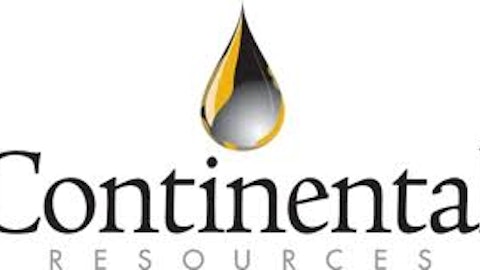It’s hard to argue the fact that Bakken has become a game-changer for U.S. oil production. While it was discovered in the 1950s the play wasn’t economically viable until more recently. Since producers began developing the play in earnest, it has produced some truly incredible numbers. Here are the 10 most incredible numbers from North Dakota’s black gold mine.
1. 14,700 miles
The Bakken and the associated Three Forks covers 14,700 square miles, making it the largest continuous crude oil accumulation in the U.S. The play covers North Dakota and Montana as well as parts of Canada. Continental Resources, Inc. (NYSE:CLR) is the largest leaseholder with more than 1 million net acres.
2. $9 million per well
It costs producers an average of $9 million to drill and complete the average well in the Bakken. Some producers enjoy below average well costs; Continental Resources, Inc. (NYSE:CLR)’ well costs are down to $8.3 million. Other producers, like the smaller Kodiak Oil & Gas Corp (USA) (NYSE:KOG), still have a way to go; its wells cost an average of $10 million.

Source: Newfield Exploration Co. (NYSE:NFX)
3. 45 years
A typical Bakken well will continue to produce oil for the next 45 years. Over those years the well will likely switch hands as the steep initial decline rates could force producers to sell wells to an MLP such as Linn Energy LLC (NASDAQ:LINE). In 2011, the company acquired Concho Resources Inc. (NYSE:CXO) assets in the Bakken, which included non-operated oil wells and an interest in 400 potential future drilling locations. Linn Energy LLC (NASDAQ:LINE), which typically acquires mature assets, is positioning itself to consolidate Bakken wells once producers, such as its partners in these wells, are ready to cash out.
4. 665,000 barrels of oil
Over those 45 years the average Bakken well will produce around 665,000 barrels of oil. The economics are exceptional even for a producer like Kodiak Oil & Gas Corp (USA) (NYSE:KOG) and its elevated $10 million well costs. For example, if oil drops to $75 a barrel then the company would still enjoy an internal rate of return of 35% and a payout of just 30 months.
5. $23 million in net profit
That same average well should yield around $23 million in profit to the producer over its life. That profit won’t come at a steady pace, instead most of it will come up front, as the oil production from a Bakken well is initially high, and then production declines very rapidly. For example, some of Newfield Exploration Co. (NYSE:NFX)‘s recent wells produced a company record 3,100 barrels of oil equivalent per day. That will produce a very fast payback, but the rate of production won’t last very long.
6. $4.3 million in taxes
The average Bakken well will generate over $4 million in taxes. This has created quite an interesting dilemma for the newly created North Dakota Legacy Trust Fund which has already accumulated over a billion dollars. That’s 63% above the state’s initial target for the fund at this point. While the state has no immediate plans for the fund, it’s looking for the best way to make use of that money.
7. $2.1 million in wages
One of the reasons why North Dakota’s unemployment rate is currently just 3.3% is because the wages paid by Bakken oil. Over the lifetime of each well it will dish out more than $2 million in salaries to those that kept its oil flowing.
8. 779,000 barrels of oil per day
This past February the Bakken produced 779,000 barrels of oil per day, which has made North Dakota the nation’s second-best oil-producing state. Production grew 39% year over year and is expected to hit a million barrels of oil per day by next April and could top 1.5 million barrels of oil per day by the dawn of the next decade. Last quarter, top Bakken producer Continental Resources, Inc. (NYSE:CLR) averaged 76,900 barrels of oil equivalent per day, while its gross production hit more than 100,000 barrels of oil equivalent per day.
9. 50,000 future wells
The industry has already drilled about 5,000 wells in the Bakken, which means that the play might only be 10% developed. This has oil-field services companies like Heckmann Corporation (NYSE:HEK) envisioning a real long-term opportunity in the play. The company, which is an environmental solutions provider focusing on the water used in fracking, has a very large Bakken operation. While some will point to falling rig counts, the industry has become much more efficient in getting its well costs down, meaning its drilling more wells with fewer rigs. That could yield even more profitable wells in the future as long as oil prices stay elevated.
10. 7.4 billion barrels of oil
Five years ago the U.S. Geological Survey estimated that the Bakken might contain 3 billion-4.3 billion barrels of oil. Now, with the development of the Three Forks formation, it’s nearly doubled the estimated amount of oil that could be pulled out of the region. Some in the industry, including Continental Resources, Inc. (NYSE:CLR), think that the estimates are still way too low, as the company believes those formations could hold 24 billion barrels of oil equivalent.
Foolish bottom line
The numbers don’t lie: The Bakken is a phenomenal oil play that should produce for many years to come. As it does, those companies operating in the region will enjoy their share of profits.
The article 10 Incredible Numbers From the Bakken originally appeared on Fool.com and is written by Matt DiLallo.
Motley Fool contributor Matt DiLallo owns shares of LINN Energy and Heckmann, and has the following options: Short Jun 2013 $4 Puts on Heckmann. The Motley Fool owns shares of Heckmann and has the following options: Long Jan 2014 $4 Calls on Heckmann and Short Jan 2014 $3 Puts on Heckmann.
Copyright © 1995 – 2013 The Motley Fool, LLC. All rights reserved. The Motley Fool has a disclosure policy.



